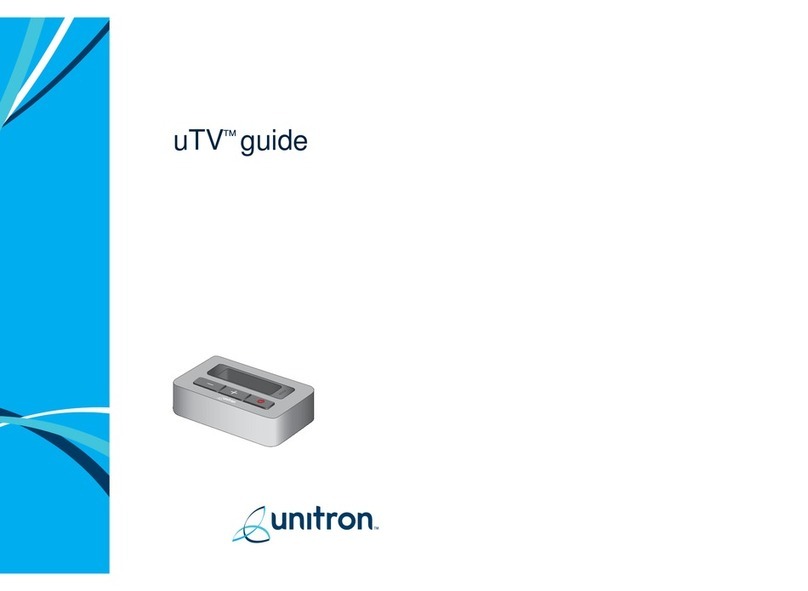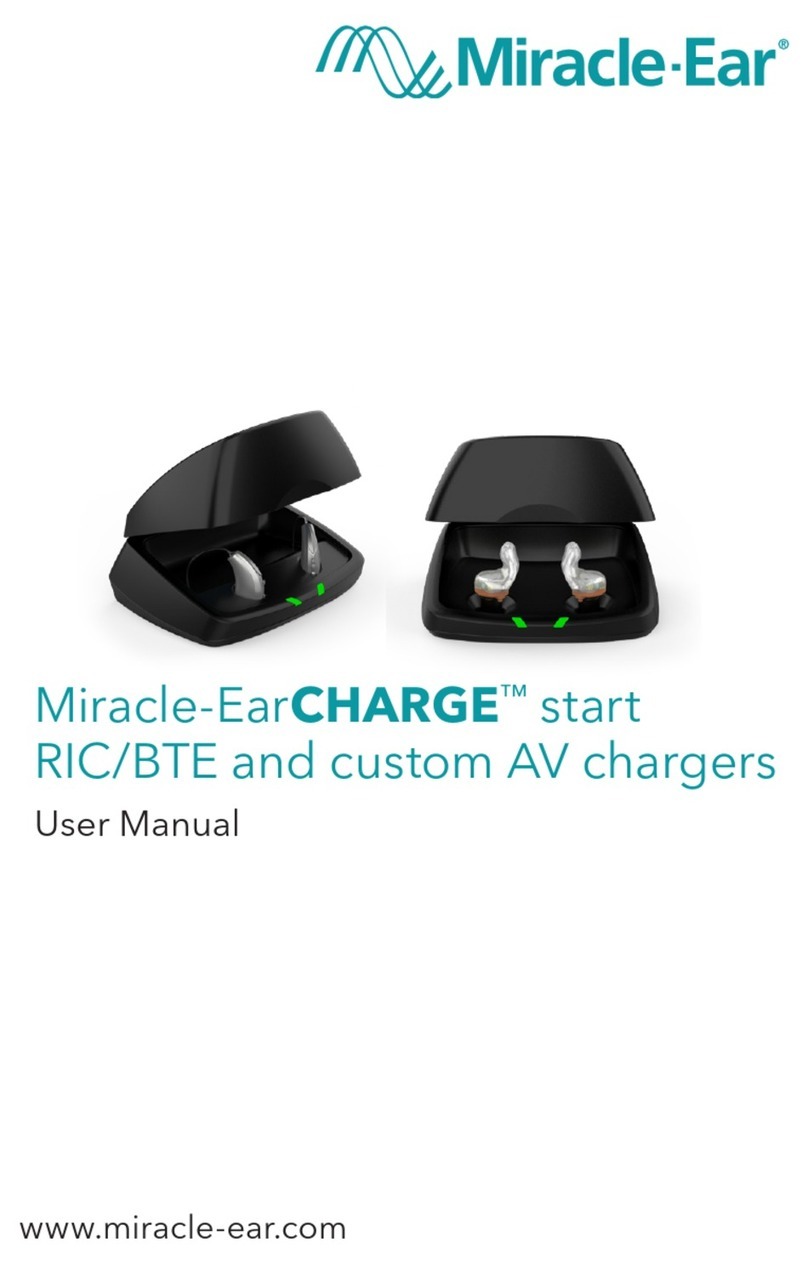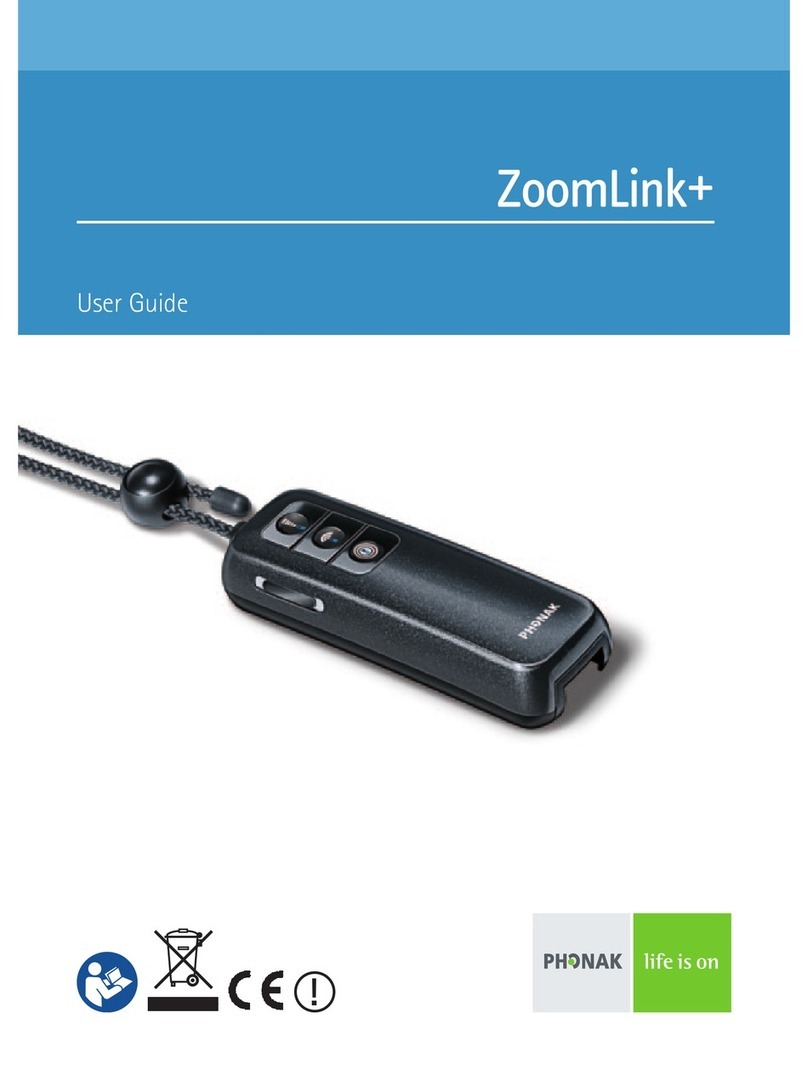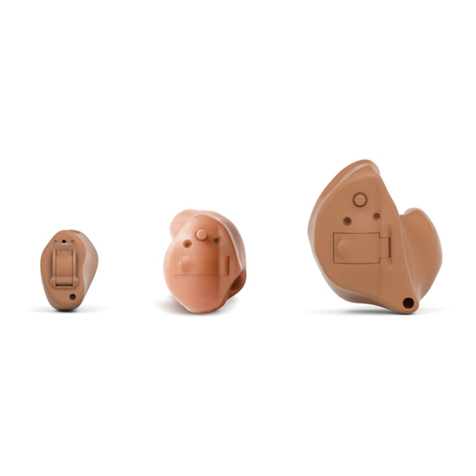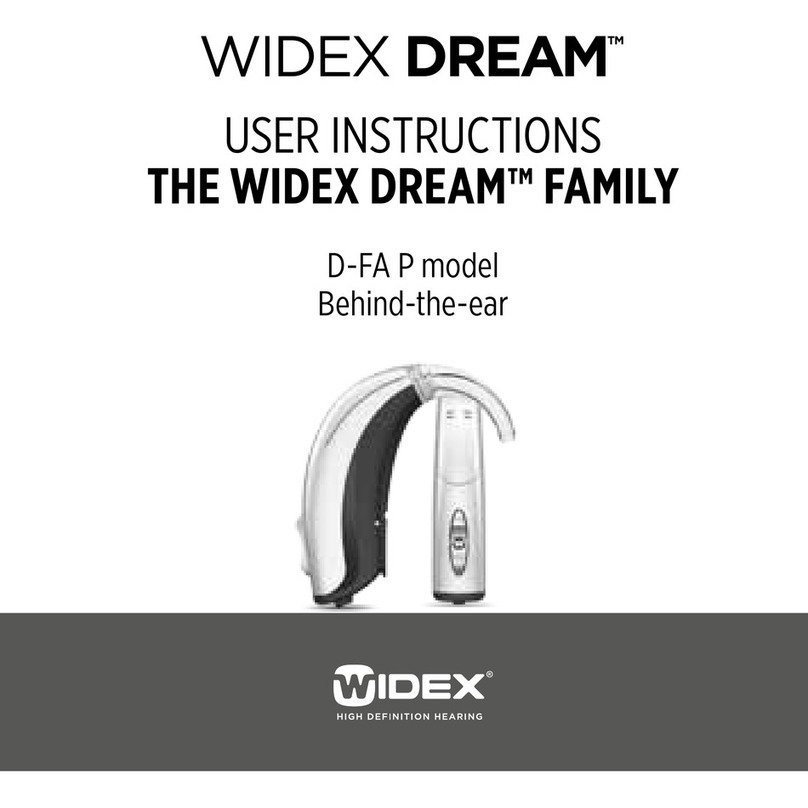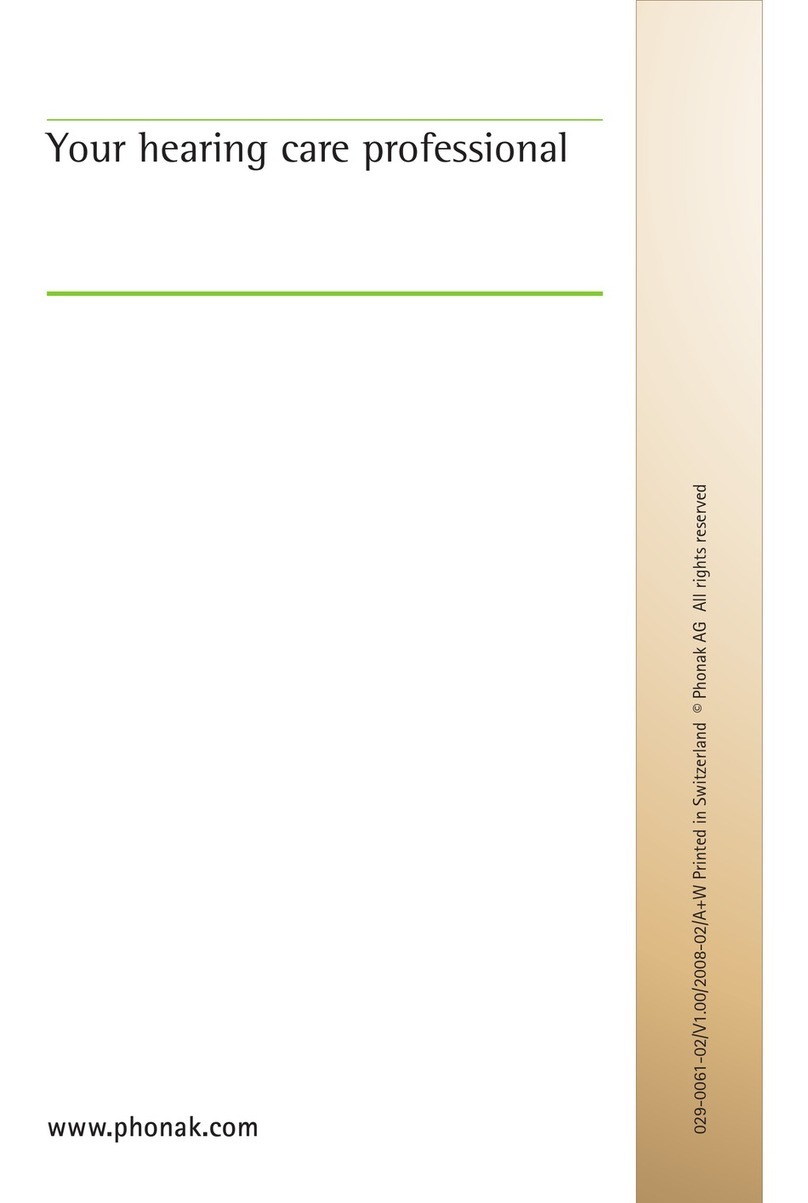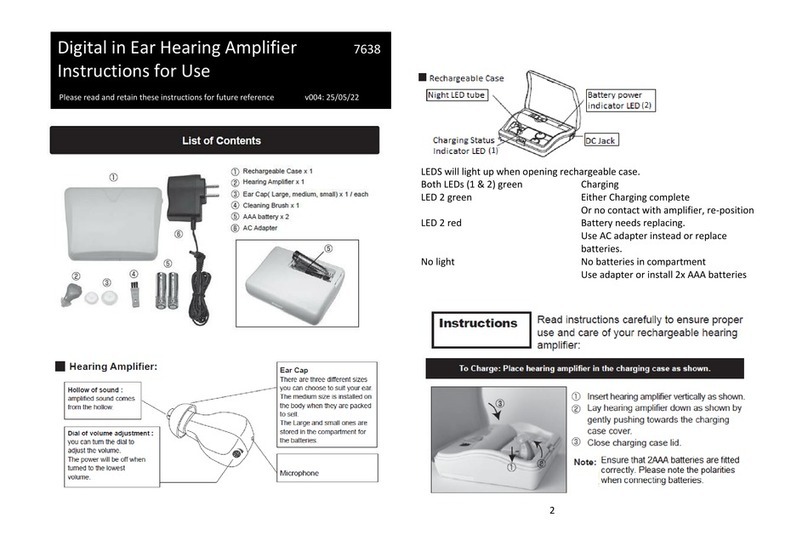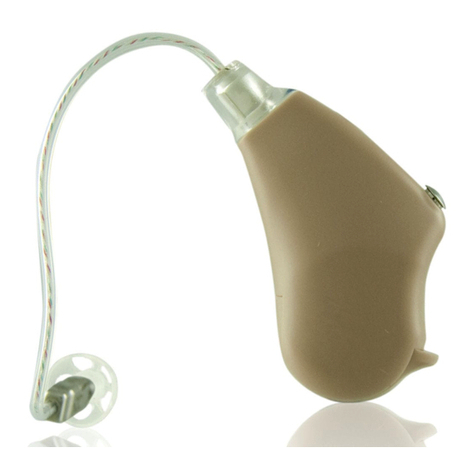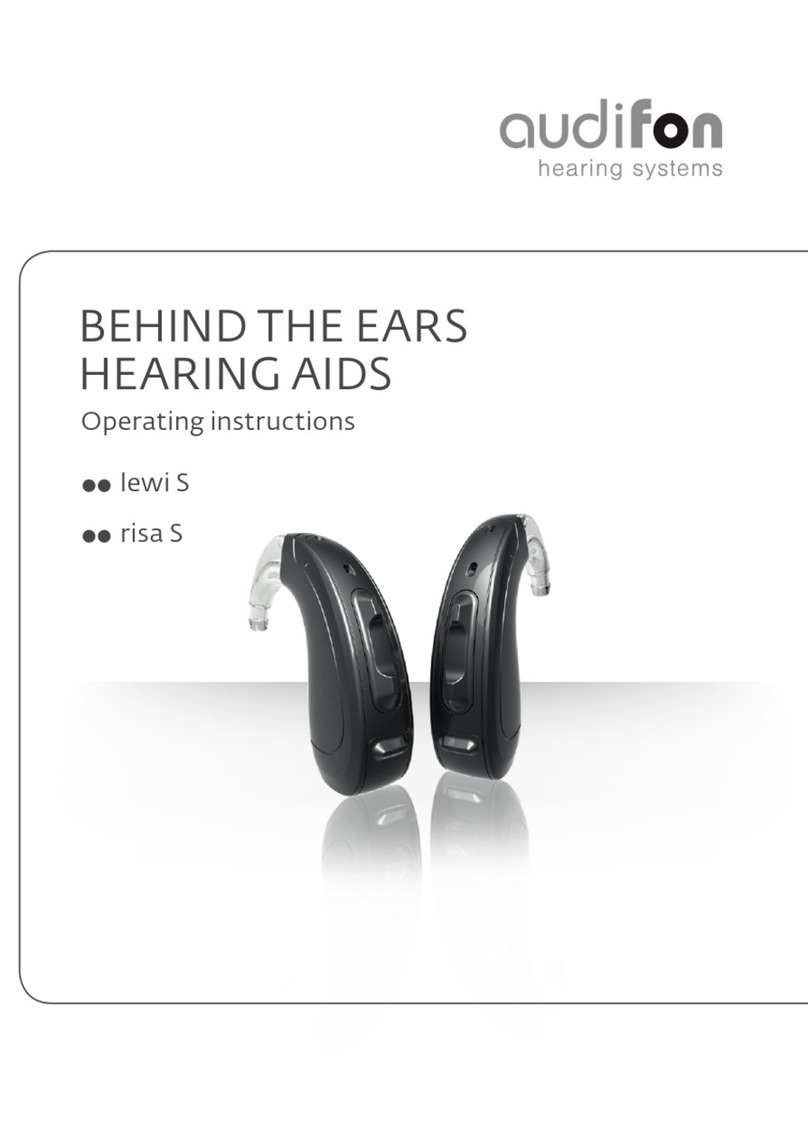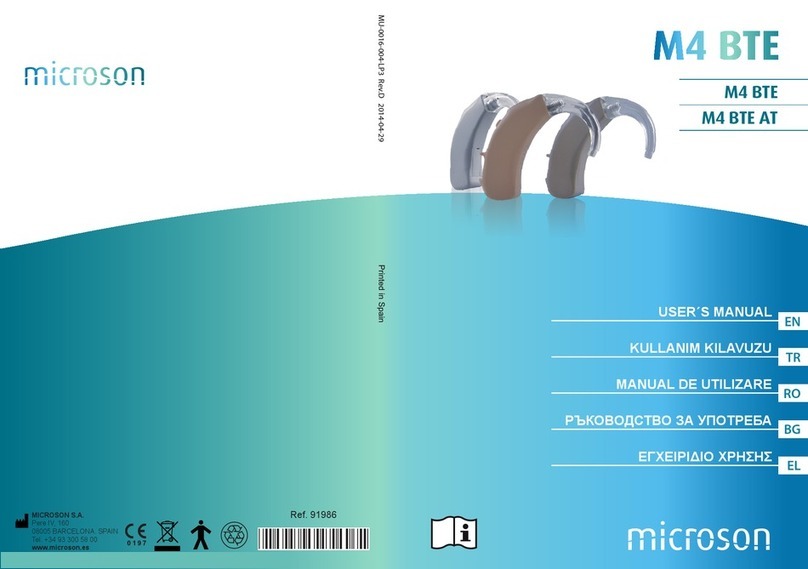NHS Xceed SP User manual

Xceed SP / UP Hearing Aid
How to use your new hearing aid
Information
for patients
and carers

Page 2of 18
Volume
Programme Button
(Press and release programme button)
One beep = Programme 1 normal / everyday
Two beeps = Programme 2 ______________
Three beeps = Programme 3 ______________
Four beeps = Programme 4 ______________
Your New Hearing Aid
Xceed SP
Xceed UP

Page 3of 18
Turning your hearing aid ON and OFF
Turn your hearing aid ON by closing the battery door completely with the
battery in place. When the battery door is closed the hearing aid will start
up by playing a jingle.
This indicates that the battery is working, andthe hearing aid is operating.
Turn your hearing aid OFF by opening the battery door slightly until a
“click” is felt.
To preserve the battery, make sure your hearing aid is switched off when
you are not wearing it.
Open the battery compartment fully to allow air to circulate whenever you
are not using your hearing aid, especially at night. When the hearing aid
is switched off it will go back to the default program and volume.

Page 4of 18
Changing batteries
The Xceed SP battery size is P13.
The Xceed UP battery size is P44.
Each battery should last 10 to 14 days. A worn-out battery should be
removed immediately.
When the battery power is low, you will hear 2 beeps, this pre-warning
starts when the battery has only a few hours of operation left. The pre-
warning will be repeated in moderate intervals to indicate it is time to
change the battery.
If the battery runs out the hearing aid turns off. When that happens, a
series of beeps are played to indicate that the hearing aid is no longer
operating.
This is not an indication of a malfunction.
Batteries are available free of charge by contacting the department.

Page 5of 18
Left/Right ear marking
Hearing aids are fitted to the uniqueness of each ear, which means if you
have two hearingaidsthen your left hearing aid is programmed differently
from your right. That is why it is important to distinguish between the left
hearing aid and the right.
In order to easily identify whether it is the left ear or right ear hearing aid,
colour markings may be applied inside the battery door.

Page 6of 18
Putting on your hearing aid with mould
Place the tip of the earmould in your ear canal, twisting slightly, making
sure that the top part of the earmould is pushed behind and under the
fold of your ear.
Gently pull up your ear and press the earmould in the direction of the
ear canal.
With the earmould positioned correctly in your ear, place the hearing aid
behind your ear by lifting its lower part and sliding it over the top of your
ear.
Replacing the tubing
The tubing in the earmould should be replaced when it becomes yellow
or stiff, usually every 6-8 months. This can be done at the Hearing Aid
Repair clinic, please call for an appointment.

Page 7of 18
Lost Hearing Aids
Take care of your hearing aid/s if they are lost or damaged you may be
charged. If this does happen, you will need to call the department for an
appointment.
Avoiding heat, humidity and chemicals
Your hearing aid must never be exposed to extreme heat e.g. left inside
a parked car in the sun. They must never be exposed to a lot of
moisture e.g. steam baths, showers or heavy rain. Nor must they be
dried in microwave ovens or other ovens.
Wipe the batteries carefully if moisture is present as it may affect their
performance.
The chemicals in cosmetics, hairspray, perfume, aftershave lotion,
suntan lotion and insect repellent can damage your hearing aid. You
should always remove your hearing aid before applying such products
and allow time for the product to dry before refitting your hearing aid. If
you use lotion, be sure to wipe your hands dry before putting on your
hearing aid.
Seven easy steps to better hearing
It takes time to adjust to a new hearing aid. How long this adjustment
takes differs from person to person. It will depend on a number of
factors, such as whether you have had a hearing aid before and the
degree of your hearing loss.
1. In the quiet of your home
Try to accustom yourself to all the new sounds. Listen to the many
background sounds and try to identify each sound. Bear in mind that

Page 8of 18
some sounds will seem different from what you are used to. You may
have to learn to identify them again. Note that in time you will get
accustomed to the sounds in your environment.
If using the hearing aid makes you tired, take them off for a little while
and have a rest. Gradually, you will begin to be able to listen for longer
periods of time. Soon, you will be able to wear your hearing aids
comfortably all day long.
2. Conversation with another person
Sit with someone else in a quiet room. Face each other so you can read
facial expressions easily. You may experience new speech sounds,
which can seem a little disturbing in the beginning. However, after the
brain has adapted to the new speech sounds, you should hear speech
clearer.
3. Listen to radio or TV
When listening to the TV or the radio, start out by listening to news
commentators since they usually speak clearly, then try other programs.
If you find it difficult to listen to TV/radio, you may want to refer to the
contacts at end of this booklet for advice on assistive devices.
4. In group conversations
Group situations are usually accompanied by a greater degree of
background noise, and are, therefore, naturally more difficult to cope
with. In such situations, therefore, focus your attention on the person
you want to hear. If you miss a word, ask the speaker to repeat.

Page 9of 18
5. Telecoil use in church, theatre or cinema
An increasing number of churches, theatres and public
buildings often have loop systems installed. These
systems send out wireless sound to be received by
the telecoil in your hearing aid. Typically, a sign will let
you know whether the place has a telecoil.
6. Using the telephone
When using the telephone, tilt the
receiver edge lightly on your cheek-bone
and position the phone slightly over the
ear close to the hearing aids microphone.
The sound then flows directly into the
hearing aids microphone opening. This
way, the hearing aids will not whistle, and
you ensure the best conditions to
understand the conversation. When you
have the receiver in this position, remember to speak directly into the
mouthpiece on the telephone in order to ensure good understanding on
the other “end of the line”.
If you find it difficult to use the telephone, you may want to contact one
of the suppliers mentioned at the end of this booklet for information and
advice.
7. Use your hearing aids all day long
The best way to ensure better hearing is to practice listening until you
can wear your hearing aids comfortably all day. In most cases, you will
not get the full benefit of the hearing aids if you use them infrequently.
Your hearing aids will not restore normal hearing, nor will they prevent
or improve a hearing impairment resulting from a physiological
condition. What they will give you, however, is help towards making
Microphone

Page 10 of 18
better use of the hearing ability that you have. If you have two hearing
aids always wear both.
The most important benefits of wearing two hearing aids are:
•Your ability to localize sounds will improve
•It will be easier to understand speech in noisy surroundings
•You will experience a fuller, more comfortable sound picture
Common Problems and their Solutions
If none of the above solutions solves the problem, contact the
department for assistance.
Symptom Possible cause Solution
No Sound
Worn-out battery Change Battery
Blocked tube
(wax/condensation) Clean tube
Intermittent or
reduced sound
Blocked tube
(wax/condensation) Clean tube
Worn-out battery Change Battery
Build-up of wax in ear
canal
Have ear checked by
GP
Whistling/Squealing
noise whilst in ear
Ear piece not inserted
correctly Reinsert hearing aid
Build-up of wax in ear
canal
Have ear checked by
GP
Tubing split Make appointment for
replacement tubing

Page 11 of 18
What to do if it goes wrong
You can contact the Hearing & Balance Service using the details below:
Telephone: 01772 522751
Email address: hearing.balance@lthtr.nhs.uk
Useful Contacts
Social Services – LCC Adult Social Care:
Hearing Impairment Team, assessment for assistive listening devices
Telephone: 0300 123 6720
Mobile SMS: 07860 031294
Minicom/textphone: 01254 220666
Fax: 01772 533661
Email: csc.acscustomerservices@lancashire.gov.uk
Access to Work:
Self-referral for an assessment at WORK to support with hearing and
communication:
Web: www.gov.uk/access-to-work
Telephone: 0800 121 7479
Textphone: 0800 121 7579
RNID
For information on hearing loss, tinnitus, assistive devices
Web: www.rnid.org.uk
Tel: 0808 8080123
Text: 07360 268 988
Email: contact@rnid.org.uk

Page 12 of 18
Hearing Link (previously Hearing Concern)
The Grange, Wycombe Road, Saunderton, Princes Risborough,
Buckinghamshire, HP27 9NS
Telephone/SMS: 07526 123255
Email: Enquiries@hearinglink.org
C2 Hear Online
Interactive multimedia videos on hearing aid use
Web: http://www.c2hearonline.com/
Relay UK (formally Next Generation Text Service)
Helping anyone with a hearing/speech impairment with communication
over the phone
Relay UK Team, Internal Box 14, Telephone House, 170-175 Moor
Lane, Preston, Lancashire, PR1 1BA.
Telephone: 0800 7311 888
Textphone/Relay UK app: 0800 500 888
Email: relay.uk.helpde[email protected]om
Socialising - BSL
Preston Deaf Club every fortnight 11-4pm at St Gerard's Centre, 17a
Brownedge Road, Lostock Hall PR5 5AA prestondeafclub@gmail.com
Free Interpreter Drop-in Sessions – support letter writing and phone
call service
Preston Deafway, Brockholes Brow, Preston, Lancashire PR1 5BB,
(PR2 5AL for sat nav purposes) – every Friday 1pm - 3pm

Page 13 of 18
Suppliers of Equipment
Connevans
Web: www.connevans.co.uk
Email: info@connevans.com
Telephone: 01737 247571
Sarabec
15 High Force Rd, Middlesbrough, TS2 1RH
Web: www.sarabec.com
Telephone: 01642 247789
Fax: 01642 230827
Mincom/textphone: 01642 251310
E-mail: mail@sarabec.co.uk
Hearing Products Ltd (HPI)
Echo House, 26/27 Haigh Park, Stockport, SK4 1QR
Web: www.hear4you.com
Telephone: 0161 480 8003
Fax: 0161 480 8006
E-mail: info@hear4you.com
Medequip Assistive Technology Limited
Unit G4
Leyland Business Park
Leyland, Preston
PR25 3GR.
Web: www.medequip-uk.com
Telephone: 01772 286573
E-mail: leyland@medequip-uk.com

Page 14 of 18
Products
Doorbells:
Portable Flashing Doorbells – B&Q, Argos, www.sarabec.com,
www.hear4you.com
Loop Systems:
Different types dependent on hearing aid, dexterity - ability to press
button/switch on hearing aids.
www.sarabec.com, www.hear4you.com
Smoke Alarms:
www.fireangel.co.uk, B&Q, Lancashire Fire and Rescue
Telephones:
www.sarabec.com, www.medequip-uk.com, Argos
Telephone ringers – BT 0800 800 150
Alarm Clocks:
www.sarabec.com, www.medequip-uk.com, Argos,
Emergency Texting Services
66247 (used in Lancashire only) – www.lancashire.police.uk or
www.lancsfireescue.org.uk
999 used in UK (mobile must be registered) –
www.emergencysms.og.uk

Page 15 of 18
Warnings
You should familiarise yourself fully with the following general warnings
and the entire contents of this booklet before using your hearing
instrument.
Batteries
Hearing instruments and batteries can be dangerous if swallowed or
used improperly. Such actions can result in severe injury, permanent
hearing loss, or can even be fatal.
•Hearing instruments, their parts, and batteries are not toys and
should be kept out of reach of anyone who might swallow these
items or otherwise cause injury to themselves
•Never change the battery of the hearing instruments in front of
infants, small children or people with learning difficulties
•Discard batteries carefully in a place where infants, small children
or people with learning difficulties cannot reach them
•Batteries have occasionally been mistaken for pills. Therefore
check your medicine carefully before swallowing any pills
•Never put your hearing instrument or batteries in your mouth for
any reason, as they are slippery and could be swallowed by
accident
•Most hearing instruments can be supplied with a tamper-resistant
battery compartment upon request. This is strongly
recommended for infants, small children, and people with
learning difficulties
•Always use batteries recommended by your Hearing Care
Professional. Batteries of low quality may leak and cause bodily
harm
•Never attempt to recharge your batteries. They may explode and
cause serious injury
•Never dispose of batteries by burning them. There is a risk that
they will explode and cause serious injury

Page 16 of 18
If a battery or hearing instrument is swallowed, see a doctor
immediately.
Usage of hearing instruments
•Hearing instruments should be used only as directed and
adjusted by your Hearing Care Professional. Misuse can result in
sudden and permanent hearing loss
•Never allow others to wear your hearing instrument as
incorrect/wrongful usage could cause permanent damage to their
hearing
Dysfunction in hearing instruments
•Hearing instruments may stop functioning, for instance if the
batteries have expired or if the tubing is blocked by moisture or
earwax. You should be aware of this possibility, in particular
when you are in traffic or otherwise dependent on warning
sounds
Interference
•Your hearing instrument has been thoroughly tested for
interference, according to the most stringent international
standards. But new technical developments constantly bring new
products into society, and some may emit electromagnetic
radiation, leading to unforeseen interference in hearing
instruments. Examples include induction cooking appliances,
shop alarm systems, mobile telephones, fax machines, personal
computer devices, X-rays, Computer tomography etc.
•Your hearing instruments are designed to comply with the most
stringent Standards of International Electromagnetic
Compatibility. However, your hearing instrument may cause
interference with other medical devices. Such interference can

Page 17 of 18
also be caused by radio signals, power line disturbances, airport
metal detectors, electromagnetic fields from other medical
devices and electrostatic discharges
Contact details
Should you require further advice or information please contact:
Audiology Department (Hearing and Balance Service)
Royal Preston Hospital
Sharoe Green Lane
Fulwood
Preston
PR2 9HT
Telephone: 01772 522751
Email: hearing.balance@lthtr.nhs.uk
Sources of further information
www.lancsteachinghospitals.nhs.uk
www.nhs.uk
www.patient.co.uk
www.accessable.co.uk
https://c2hearonline.com/
Follow us on social media @lancshospitals
Lancashire Teaching Hospitals NHS Foundation Trust is not
responsible for the content of external internet sites.
All our patient information leaflets are available on our website for
patients to access and download:
www.lancsteachinghospitals.nhs.uk/patient-information-leaflets

Page 18 of 18
Lancashire Teaching Hospitals is a smoke-free site. Smoking is not
permitted anywhere on any of our premises, either inside or outside the
buildings. Our staff will ask you about your smoking status when you
come to hospital and will offer you support and advice about stopping
smoking this will include Nicotine Replacement Therapy to help manage
your symptoms of withdrawal and the opportunity to speak to a nurse or
advisor from the specialist Tobacco and Alcohol Care Team.
If you want to stop smoking, you can also contact Smokefree
Lancashire on Freephone 08081962638.
Please ask a member of staff if you would like help in
understanding this information.
This information can be made available in large print,
audio, Braille and in other languages.
Department: Audiology
Division: Hearing & Balance Service
Production date: November 2023
Review date: November 2026
JR 1067 v1
This manual suits for next models
1
Table of contents
Other NHS Hearing Aid manuals
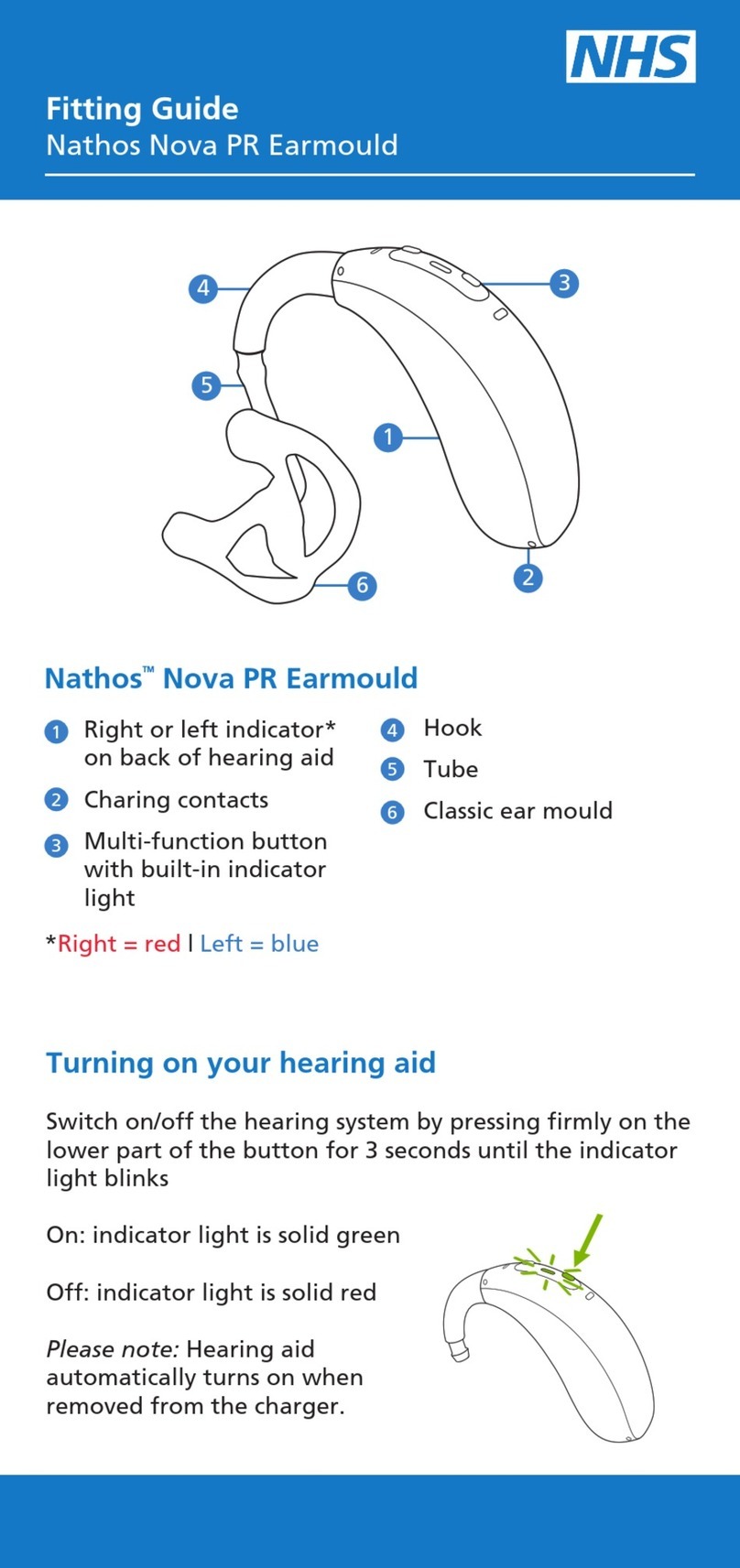
NHS
NHS Nathos Nova PR Earmould Assembly instructions
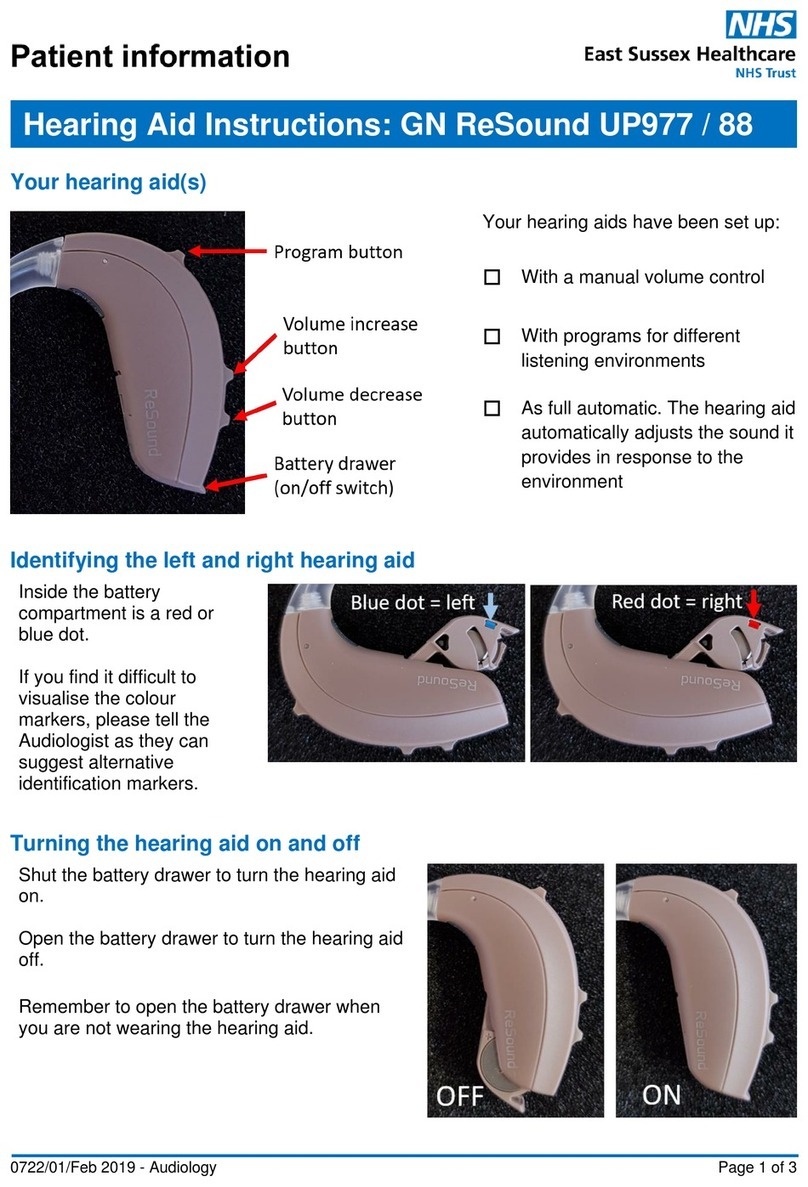
NHS
NHS GN ReSound UP977 User manual

NHS
NHS Phonak Auto M User manual

NHS
NHS Nathos Nova PR Slimtube Assembly instructions

NHS
NHS Phonak Marvel PR User manual
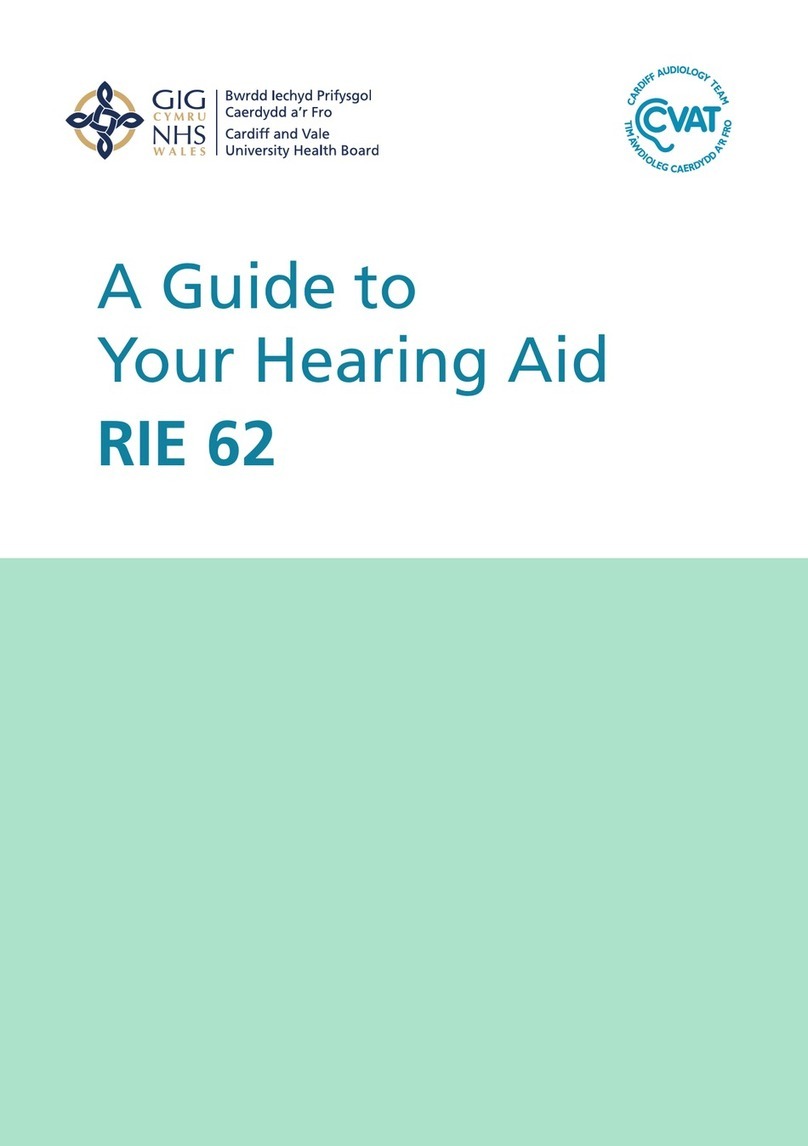
NHS
NHS RIE 62 User manual

NHS
NHS Nathos Nova M Slimtube Assembly instructions
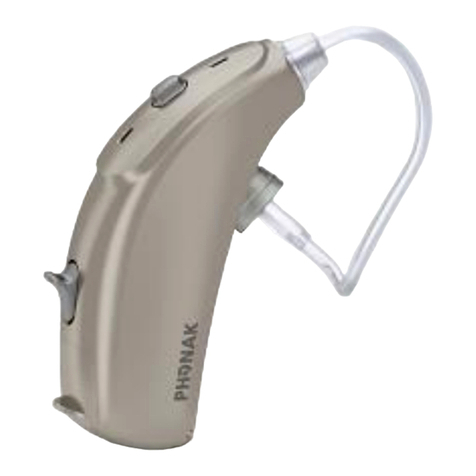
NHS
NHS White Noise Generator User manual

NHS
NHS Signia User manual
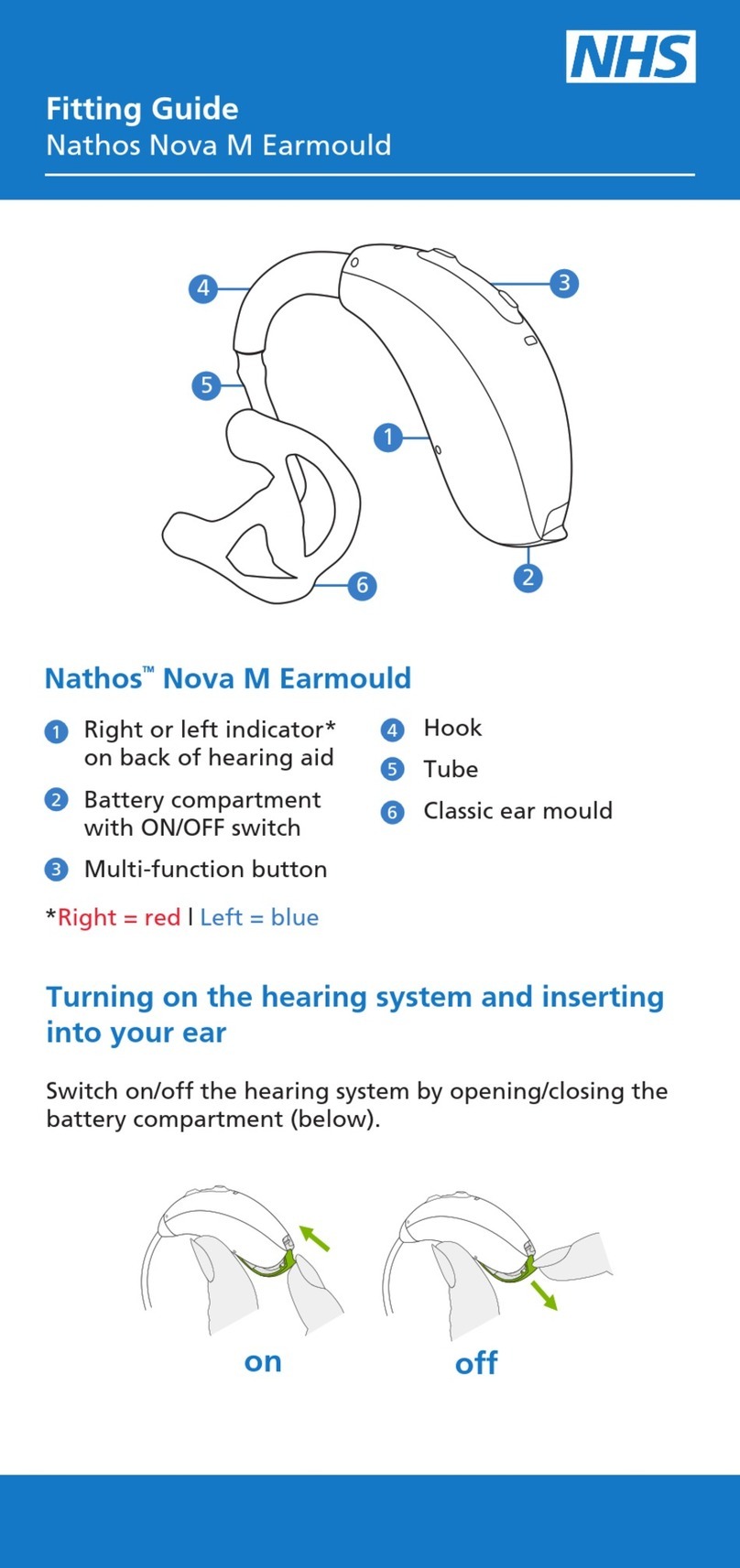
NHS
NHS Nathos Nova M Earmould Assembly instructions
